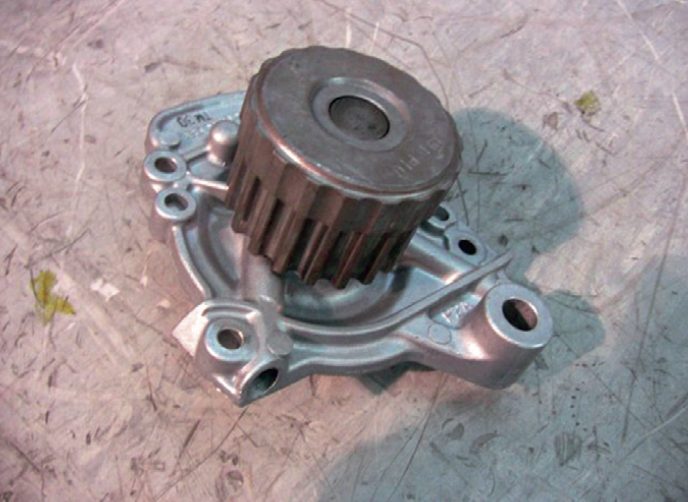Introduction: Water pumps are an essential component of an engine’s cooling system. They work by circulating coolant through the engine to absorb heat and dissipate it through the radiator. To power the water pump, an engine uses a water pump drive gear or cam belt. In this blog, we will discuss everything you need to know about water pump drive gears or cam belts.
What is a Water Pump Drive Gear (Cam Belt)? The water pump drive gear or cam belt is a component of the engine that drives the water pump. It is a toothed belt that connects the crankshaft to the water pump. As the crankshaft rotates, the cam belt turns the water pump, which circulates coolant through the engine.
Types of Water Pump Drive Gears: There are two types of water pump drive gears – timing belts and timing chains. Timing belts are made of rubber and have teeth that mesh with the gears of the engine. Timing chains, on the other hand, are made of metal and are more durable than timing belts. However, timing belts are quieter and are less expensive to replace.
How Often Should You Replace Your Water Pump Drive Gear (Cam Belt)? The timing of replacing the water pump drive gear or cam belt varies depending on the make and model of your vehicle. It is recommended that you refer to your vehicle owner’s manual for the manufacturer’s recommended replacement interval. In general, most manufacturers recommend replacing the cam belt between 60,000 and 100,000 miles. However, it’s important to note that the lifespan of a cam belt can be affected by factors such as driving conditions, maintenance, and environmental factors.
Why is it Important to Replace Your Water Pump Drive Gear (Cam Belt)? A failing cam belt can cause serious damage to your engine. If the belt snaps, the water pump will stop functioning, and the engine will overheat, potentially causing severe damage. Additionally, if the cam belt becomes stretched or worn, it can cause the water pump to malfunction, leading to engine overheating and damage. Replacing the cam belt at the recommended interval can prevent these problems and prolong the life of your engine.
Conclusion: In conclusion, the water pump drive gear or cam belt is an essential component of an engine’s cooling system. It powers the water pump, which circulates coolant through the engine to absorb and dissipate heat. Replacing the cam belt at the manufacturer’s recommended interval is important to prevent engine damage and prolong the life of your engine. If you’re unsure about the condition of your cam belt, it’s always best to consult with a professional mechanic.
One important thing to note is that the timing of replacing the cam belt can vary depending on the make and model of your vehicle. Some vehicles may have a longer recommended replacement interval, while others may require more frequent replacement. It’s always best to refer to your vehicle owner’s manual or consult with a professional mechanic to determine the recommended replacement interval for your specific vehicle.

It’s also important to note that the water pump drive gear or cam belt is just one part of the engine’s cooling system. Other components, such as the water pump itself, thermostat, and radiator, also play important roles in maintaining the proper temperature of the engine.
In addition to timing belts and timing chains, there is another type of water pump drive gear called a serpentine belt. Serpentine belts are flat, wide belts that power multiple components in the engine, including the water pump. They are often used in modern engines and can be more durable than timing belts or chains.
Finally, it’s important to emphasize the importance of regular maintenance in prolonging the life of your engine and its components, including the water pump drive gear or cam belt. Regular oil changes, coolant flushes, and inspections can help identify potential issues before they become major problems. It’s also important to pay attention to any warning signs, such as unusual noises or overheating, and have them addressed promptly by a professional mechanic.
Advantages of Water Pump Drive Gear (Cam Belt):
- Efficient: The water pump drive gear or cam belt is an efficient way to transfer power from the engine to the water pump. The toothed belt allows for smooth and precise power transmission, which helps the water pump to function properly.
- Cost-effective: Compared to other components of an engine’s cooling system, such as the water pump or radiator, the cam belt is relatively inexpensive. This makes it a cost-effective solution for powering the water pump.
- Quiet operation: Timing belts are known for their quiet operation, which helps to reduce engine noise and create a more comfortable driving experience.
Disadvantages of Water Pump Drive Gear (Cam Belt):
- Limited lifespan: Timing belts have a limited lifespan and must be replaced at regular intervals to prevent engine damage. This can be inconvenient and costly for vehicle owners.
- Vulnerable to damage: Timing belts are vulnerable to damage from exposure to heat, oil leaks, and other factors. If the belt becomes damaged or stretched, it can cause the water pump to malfunction and lead to engine overheating.
- Labor-intensive to replace: Replacing a timing belt can be a labor-intensive process, requiring the removal of other components of the engine. This can make the replacement process time-consuming and expensive.
- Can cause catastrophic engine damage: If a timing belt fails while the engine is running, it can cause catastrophic engine damage, requiring expensive repairs or even engine replacement.
In summary, while water pump drive gears or cam belts are an efficient and cost-effective way to power the water pump, they have some drawbacks, including a limited lifespan, vulnerability to damage, and the potential for catastrophic engine damage if they fail. Regular maintenance and replacement at the recommended intervals can help prevent these issues and prolong the life of your engine.





